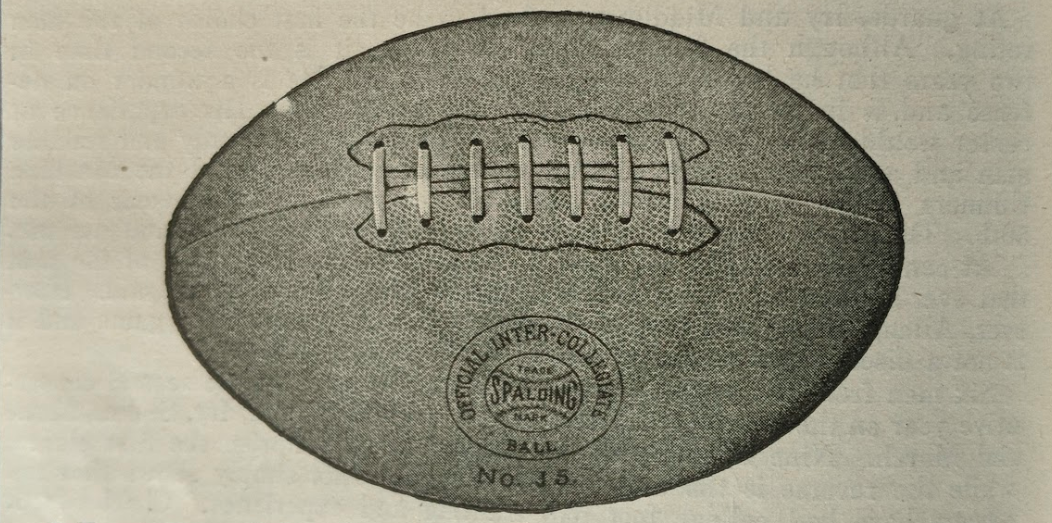The First Thanksgiving Day Football Game
Pigskin Dispatch's Part 9 in the Series on American Football History
.jpg)
The Yale University 1886 team photo taken by an unknown photographer, courtesy of Wikimedia Commons.
The late 1880’s catapulted many sound fundamentals of football’s rules that are still in our era’s version of the pigskin game. These were the building block years that laid out the foundation of our great game. Our mission in this series is to leave “no stone unturned” and to look at football’s advancement each year. We will continue this mission by picking up with the year 1886 at some important items of interest from the rules conventions of that year.
Convention of May 5, 1886
Once again the Fifth Avenue Hotel in New York, New York hosted the convention for the football rules organization. The highlight of this meeting was that Harvard was requesting reinstatement into the organization as football was once again alive in the Boston school. The growing popularity of the game around the region pressured the faculty of Harvard to rethink their earlier abolishment of the game on school grounds.
The most important historic development for football though was a rules resolution that passed. Princeton representatives C.M. DeCamp and H.S. Savage initiated a very significant proposal to the board. They suggested that something must be done to restrict the rush of the defense so as not to rough up the very vulnerable snapper of the ball. The rule simply stated that the centre (yes correctly spelled) should be, “permitted to snap the ball without any interference from opponents.” This is the precursor to the roughing the snapper rules of today.
The October 9, 1886 convention
Milestones of sorts occurred in this meeting that would help mold ideas for football into the future. The first was a decision by the board to play the championship game of that year between Princeton and Yale on Thanksgiving Day. To my knowledge this is the first of the famous Thanksgiving Day games. Well the game got off to a shakey start as the scheduled referee was a no show. Because of this the contest started a tad later than wanted with a substitute ref. This poor fella did not have an easy day of it either, as once again, just like two years earlier, darkness ended the game early. Yale was up 4-0 late in second half of the game. However under the rules of that era, the game was declared a "no contest" by the substitute referee, and the final score was recorded as a 0–0 tie. After a special meeting of the Intercollegiate Football Association Committee (sounds like a broken record eh?) held to review the game, the Association issued a two-part resolution - that (1) Yale should have been acknowledged the winner, but that (2) under their existing rules, the Association did not have the authority to award the game to them. Uhgg! Not again!
Yale ended their season with a 9-0-1 record as Princeton was unblemished at 7-0-1. Harvard finished 12-2 with Lafayette at 10-2. Out West California sported a 6-2-1 record and in the midwest Cincinnati, Wabash and Michigan all wrapped up their campaigns with 2-0 records.

The University of California 1886 team photo taken by an unknown photographer, courtesy of Wikimedia Commons.
The state of Vermont finally took the gridiron plunge as it was the last state in New England at that point to have a football contest. The first intercollegiate game in the state of Vermont happened on November 6, 1886, between Dartmouth and Vermont at Burlington, Vermont. In this game Dartmouth won 91 to 0.

The Spalding Football Rules books of 1921 still pictured the Lillywhite J5 football as the official ball.
Another big step that came out of this meeting of the minds of football was to adopt one standard ball for use in games. The Lillywhite number “J” was the only ball permitted for use in match games for teams in the organization.
Remember that the history of football up till that time was this. The first football was a pig's bladder, inflated with human lung power, and knotted at the end like a balloon. Shoemakers then made a leather case for the ball to match the shape of the bladder. This was "plum shaped"; rounder than today's ball, but certainly not spherical.
In 1862 came the invention of an India rubber bladder and a pump with which to inflate it. This allowed the production of a round ball, though some manufacturers still had a button at each end of the ball to hold the stitching together at the point where the leather panels met. "Buttonless balls" was a prime marketing buzzword for suppliers and manufacturers in the 1880s! Lillywhite was an English rugby ball manufacturer and was the leader of those years in ball production. There was nothing in the early rules about the size of the ball to be used. Some of those used in the early years were enormous by today's standards. After the tape measure was produced, the law became a ball of average circumference of not less than 27 inches and not more than 28 inches. This rule was extended to encompass all games in 1883.
The conference also changed wording in the rules to allow a defense to start their rush. Previous wording that said the defensive charge could start with offensive “motion” was changed to read that the rush could not start till the ball was “in play.”
March 26, 1887 rules convention
The months leading up to this convention were in debate of who, if anyone, won the championship game of 1886 between Yale and Princeton which was ended before completion.
This convention focused on rules of the game and empowered the referee with even more clout. A resolution was passed that stated “rules should be enforced rigidly by referees, and that captains should instruct their men against holding, roughing, and all other objectionable features.” The group even went as far as making all varsity captains sign a resolution there by swearing to coach their respective teams to play fairly and by the rules.
Other major rules changes from this conference were to make it a must for teams to try for a goal after a touchdown. Previously the wording of the rule simply stated, “Shall try for goal.” The rule was to prevent a team from deliberately missing the try for goal in order to obtain another touchdown due to the ball not being dead under the old rules.
I am not quite sure as to this reasoning as in those days a touchdown was worth 2 points and a goal after a TD was worth 4 points. The teams had their own reasons for wanting to do this and it is something that is beyond this writer’s understanding of the game of that time.
Please find the continuation of this story in the next edition of the Dispatch’s football history lesson coming soon titled “ The Umpire Strikes Back.” Right here on PigskinDispatch.com, your place for the good news about football.
We are able to give this in depth look from so long ago in history by careful research. Using someone who was contemporary to the period is the best source. So a very special shout out to our main source of reference information for this article is from Parke H. Davis in his 1911 book Football-The American Intercollegiate Game.



.jpg)





